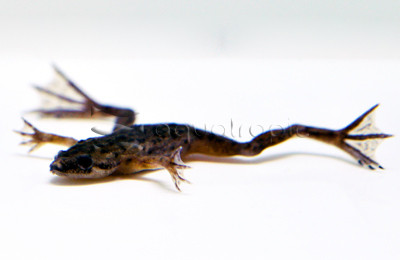African Dwarf Frog (Hymenochirus curtipes)

Frogs are not a traditional aquarium inhabitant. Their amphibious, jumping ways tend to be rather antithetical to a fully aquatic existence. But, there are a select few members of the group who do spend their entire lives underwater. One of the most famous of these is the African Clawed Frog (Xenopus laevis), a mid-sized species used widely in scientific research and regularly available to aquarists. Lovely though it may be, it’s capacious mouth makes it a poor choice for most fish tanks. But, the same is not true for its smaller cousin, the African Dwarf Frog.
Hymenochirus is a small genus of four species distributed among the tropical forests of equatorial Africa. All look more or less the same. They come in muted earth tones, often with numerous spots. This helps to camouflage them against the muddy bottoms where they spend much of their time on in the wild. The maximum size is typically a couple inches and makes them an ideal choice for a peaceful community tank.
The main difficulty with keeping a Dwarf Frog is in making sure that they get enough to eat in captivity. Though their metabolic needs are relatively low, they still need to be fed several times a week. In an aquarium full of active bottom-dwellers, this can be easier said than done. Fortunately, they are not terribly picky eaters and will greedily smash nearly any available food into their open mouths (with the exception of flake food… don’t expect your frog to ever touch flakes!). Some good choices include bloodworms, mysis shrimp, chopped krill, and sinking carnivore pellet. But, be sure to offer a variety of options, as any one food may prove to be lacking in certain nutrients if fed exclusively.
Multiple individuals of this peaceful species can be kept together. Breeding is quite rare without some effort on the part of the aquarist. But, even if breeding is not something you’re interested, you’ll still be treated to the lusty croaks of this tiny frog if you listen closely late at night. Rather than the riotous chorus that you might expect from a pond full of bullfrogs on a warm summer evening, the sound made by Hymenochirus is generously referred to as a muffled chirp. You can recognize males of this group by the small red or white spot present behind the forelimbs and their smaller, less-rotund proportions.